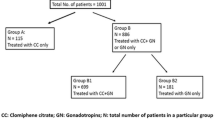Abstract
Purpose
Although intrauterine insemination is one of the oldest techniques in reproductive medicine, its significance is still controversially discussed. Many factors have been reported as influencing pregnancy rates after IUI. The aim of this retrospective analysis is to evaluate the success rate of repeated inseminations depending on the type of ovarian stimulation.
Methods
Patients who underwent intrauterine insemination in Wiesbaden Kinderwunschzentrum between 1998 and 2010, not older than 45 years of age, with male subfertility were included in this study. On the whole, 5,346 inseminations on 2,180 patients were analyzed retrospectively.
Results
Females’ mean age was 34.1, ranging from 19–45 years. In 433 cycles an insemination was performed during a natural cycle. 4,020 cycles were stimulated with recombinant FSH, 596 cycles with clomiphene, 194 with urinary FSH, 103 with HMG. The pregnancy rates range from 7.4 % in the clomiphene group to 14.4 % in the urinary FSH group. Clomiphene stimulation seems to offer the significantly lowest pregnancy rate (p = 0.03). The other types of stimulation do not differ significantly from each other concerning the pregnancy rate. Patients under 39 years of age do not profit from any ovarian stimulation. In 40 and more years of old patients, pregnancy rates are higher, if any stimulation was performed.
Conclusion
To sum up, clomiphene stimulation showed to offer significantly lower pregnancy rates in comparison to the natural cycle, FSH stimulation and HMG stimulation in IUI treatment. While women younger than 40 seem not to profit from any ovarian stimulation, women over 40 do profit.


Similar content being viewed by others
References
Merviel P, Heraud MH, Grenier N, Lourdel E, Sanguinet P, Copin H (2010) Predictive factors for pregnancy after intrauterine insemination (IUI): an analysis of 1,038 cycles and a review of the literature. Fertil Steril 93:79–88
Vargyas JM, Morente C, Shangold G, Marrs RP (1984) The effect of different methods of ovarian stimulation for human in vitro fertilization and embryo replacement. Fertil Steril 42(5):745–749
Lunenfeld B (2004) Historical perspectives in gonadotrophin therapy. Hum Reprod Update 10:453–467
Casper RF (2005) Are recombinant gonadotropins safer, purer and more effective than urinary gonadotropins? Reprod Biomed Online 11:539–540
Practice committee of the American society for reproductive medicine gonadotropin preparations: past, present, and future perspectives (2008) Fertil Steril 90:S13–S20
Giudice E, Crisci C, Eshkol A, Papoian R (1994) Composition of commercial gonadotrophin preparations extracted from human postmenopausal urine: characterization of non-gonadotrophin proteins. Hum Reprod 9:2291–2299
Filicori M, Cognigni GE, Pocognoli P et al (2003) Comparison of controlled ovarian stimulation with human menopausal gonadotropin or recombinant folliclestimulating hormone. Fertil Steril 80:390–397
Organisation WH (1999) WHO laboratory manual for the examination of human semen and sperm-cervical mucus interaction, 4th edn. Cambridge University Press, Cambridge
Schröder AK, Pelikan S, Tauchert S, Griesinger G, Felberbaum R, Diedrich K (2004) Prognostische Faktoren für den Erfolg einer intrauterinen Insemination: Eine Evaluation von 1005 Zyklen bei 349 Frauen. Geburtsh Frauenheilk 64(10):1052–1060
Hughes EG (1997) The effectiveness of ovulation induction and intra-uterine insemination in the treatment of persistent infertility: a meta-analysis. Hum Reprod 12:1865–1872
Cantineau AE, Cohlen BJ, Heineman MJ (2007) Ovarian stimulation protocols (anti-oestrogens, gonadotrophins with and without GnRH agonists/antagonists) for intrauterine insemination (IUI) in women with subfertility. Cochrane Database Syst Rev 2:CD005356
Dankert T, Kremer JA, Cohlen BJ, Hamilton CJ, Pasker-de Jong PC, Straatman H et al (2007) A randomized clinical trial of clomiphene citrate versus low dose recombinant FSH for ovarian hyperstimulation in intrauterine insemination cycles for unexplained and male subfertility. Hum Reprod 22:792–797
Ecochard R, Mathieu C, Royere D, Blache G, Rabilloud M, Czyba JC (2000) A randomized prospective study comparing pregnancy rates after clomiphene citrate and human menopausal gonadotropin before intrauterine insemination. Fertil Steril 73(1):90–93
Rashidi M, Aaleyasin A, Aghahosseini M, Loloi S, Kokab A, Najmi Z (2013) Advantages of recombinant follicle-stimulating hormone over human menopausal gonadotropin for ovarian stimulation in intrauterine insemination: a randomized clinical trial in unexplained infertility. Eur J Obstet Gynecol Reprod Biol. doi:10.1016/j.ejogrb.2013.03.002
Goverde AJ, McDonnell J, Vermeiden JP, Schats R, Rutten FF, Schoemaker J (2000) Intrauterine insemination or in vitro fertilisation in idiopathic subfertility and male subfertility: a randomised trial and cost-effectiveness analysis. Lancet 355:13–18
Goverde AJ, Lambalk CB, McDonnell J, Schats R, Homburg R, Vermeiden JP (2005) Further considerations on natural or mild hyperstimulation cycles for intrauterine insemination treatment: effects on pregnancy and multiple pregnancy rates. Hum Reprod 20:3141–3146
Acknowledgments
We assure that there was no financial support (no industry grants, no unrestricted grants, no endowments, no stock options, no paid consultant, no other arrangement that might be construed as a conflict of interest) to the investigators or their parent institution.
Conflict of interest
None.
Author information
Authors and Affiliations
Corresponding author
Additional information
R. Gomez and M. Schorsch contributed equally.
Rights and permissions
About this article
Cite this article
Gomez, R., Schorsch, M., Steetskamp, J. et al. The effect of ovarian stimulation on the outcome of intrauterine insemination. Arch Gynecol Obstet 289, 181–185 (2014). https://doi.org/10.1007/s00404-013-2952-3
Received:
Accepted:
Published:
Issue Date:
DOI: https://doi.org/10.1007/s00404-013-2952-3




